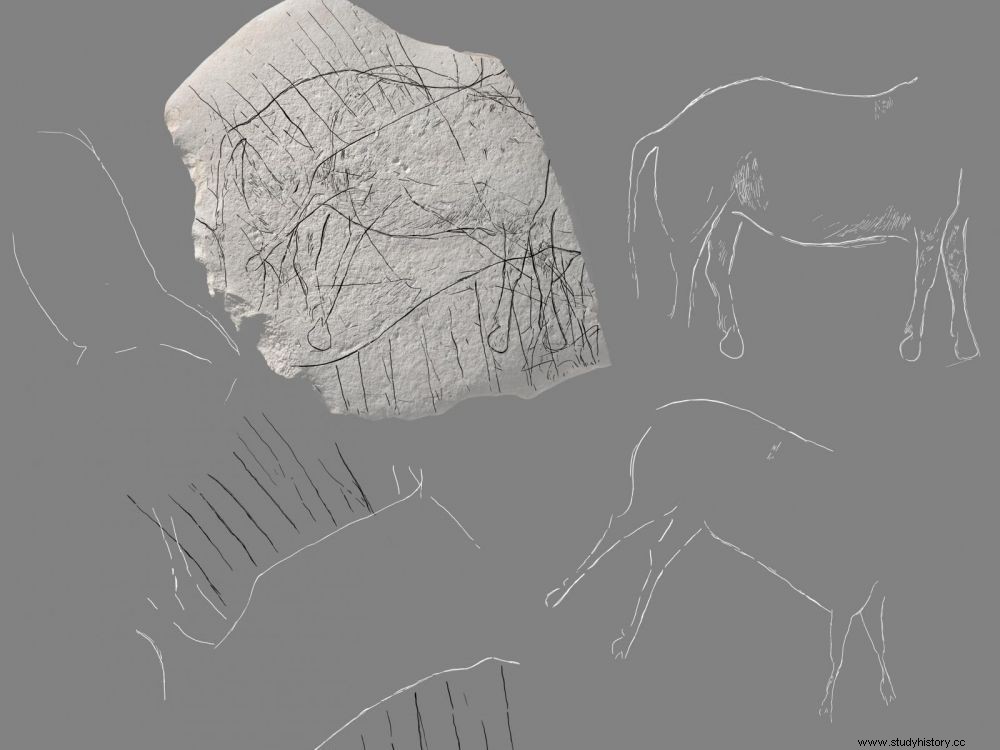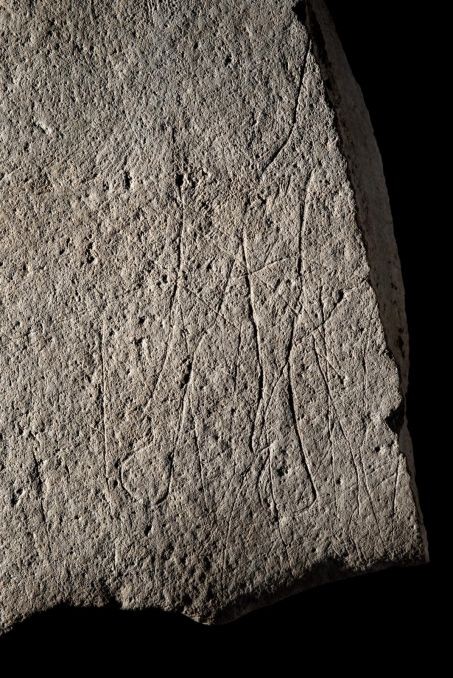An exceptional plaque engraved with animal silhouettes, presented as "the last figurative work of the Paleolithic", was discovered in the heart of the city of Angoulême, famous for hosting the International Comics Festival for 30 years. A wink due to chance, announced a few days before the start of the National Archeology Days on June 14, 15 and 16, including Sciences et Avenir is a partner.

Engraved horses, deer... Extremely rare engravings from the end of the Paleolithic period unearthed in Angoulême.
"The cry at seeing the carvings appear must have resounded throughout the city !", says Miguel Biard, paleolithician, head of the excavations, still emotional when the official announcement of this exceptional discovery was made on June 5, 2019 in the halls of the honorable Société d'Encouragement pour l'Industrie Nationale in Paris by Dominique Garcia, president of the National Institute for Preventive Archeology (Inrap).This discovery "of international importance" , produced in December 2018, being the discovery in Angoulême (Charente) of a prehistoric plaque from the Final Palaeolithic dated 12,000 years old, decorated on both sides with animal figures and geometric patterns.
"Angoulême has been the capital of comics for 12,000 years!"
The surprise took place when archaeologists only had three days left to complete the excavation of an ancient prehistoric hunting site occupied between 8,000 and 12,000 years ago, and today located on Renaudin islet, a district of the Angouleme station. The place is being renovated to create a business center. "Such a discovery in the capital of comics was a very strong moment and put balm to our hearts, at a time when some are talking about wanting to relocate the festival to the Paris region… In reality, Angoulême has been the capital of comics for 12,000 years!" , says Jean-François Dauré, president of the Greater Angoulême urban community. This slab of siliceous sandstone extracted from the ground measures 28 cm long and 18 cm wide and still reveals the sketches of five quadrupeds with slender silhouettes, a horse and four other herbivores. All of them being curiously acephalous (headless). Superimposed and made on both sides of the block, the delicate prehistoric figures present perfectly mastered anatomical features and also include a kind of hatching. Well-known fasces of the so-called "Azilian" period to which this brochure is linked.

Side A, of the incised plaque, anterior details. ©Denis Gliksman / Inrap
"It is indeed in an archaeological layer perfectly dated to 12,000 years, that the incised stone was found", explains Valérie Feruglio, attached to the Pacea laboratory (From prehistory to the present:culture, environment and anthropology) of the University of Bordeaux and UMR 5199 of the CNRS which analyzed the object. We are in front of the last known figurative works of Palaeolithic art , works of the ultimate hunter-gatherer groups, continues the parietal art specialist, a long-time member of the research team at the famous Chauvet cave (Ardèche) and who now devotes herself to that of Cussac (Dordogne) and its XXL-sized animal engravings.
This discovery upsets the knowledge of specialists who until then considered that the Azilian period – whose fame comes from an intriguing production of pebbles decorated with signs engraved and painted with red ocher – marked the abandonment of naturalistic figurative art in favor of geometric shapes. On the contrary, it shows that it persisted at the twilight of the Azilian era, 2000 years after the shales decorated with animal figures dated 14,500 years ago and found between 2013 and 2017 on the site of the Rocher de l'Impératrice, near Plougastel- Daoulas (Finistère) and which were considered until recently as the oldest. The fall of a tree, had at the time revealed the presence of engraved plaques, among which a horse and an auroch's head, found in the middle of arrowheads and flint tools. These figures will be followed by "new graphic codes", in beams and red dots.
National Archeology Days
More than 1100 places in France – and for the first time in fifteen European countries – will welcome the public on June 14, 15 and 16 during the National Days of Archeology, of which Sciences et Avenir is a partner. Everyone will be able to go to excavation sites, meet archaeologists, discover laboratories, visit museums, all managed by the National Institute for Preventive Archaeological Research (Inrap), under the aegis of the Ministry of Culture. In France, around ten archaeological villages can be visited in Marseille, Nice, Mandeure, Orléans, Rennes, Saint-Germain-en-Laye, Toulouse, Aléria, Lyon or Troyes. In 2018, more than 200,000 people moved.
